The green terror cichlid is a strikingly colorful fish belonging to the cichlid family, known for its vivid blues and greens. Despite its intimidating name, this species has become a popular choice among aquarium enthusiasts for its vibrant appearance and engaging personality. In this article, we will delve into essential information about proper care, feeding strategies, and suitable tank mates for the green terror cichlid, ensuring that both beginners and experienced aquarists can provide an optimal environment for this fascinating fish.
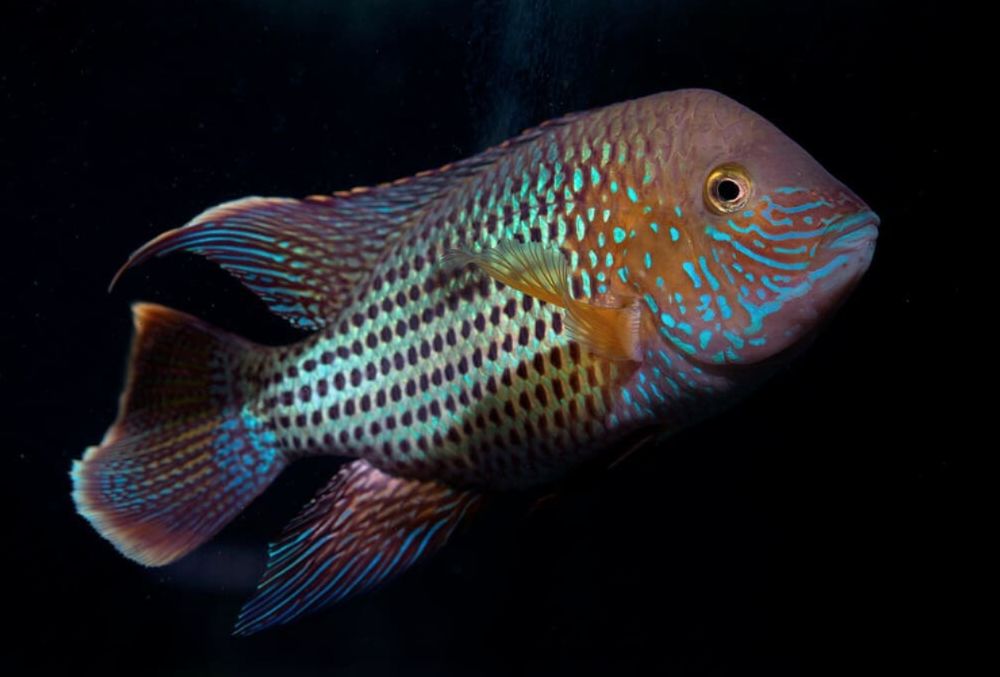
Contents
Habitat in the wild
The green terror cichlid belongs to the Cichlidae family, a diverse group of freshwater fish celebrated for their vibrant colors, territorial behavior, and complex social interactions. These traits make cichlids a favorite among aquarium hobbyists.
First described by Albert Karl Ludwig Gotthilf Günther in 1860, the green terror’s classification has undergone significant changes over the years. Initially classified within the Aequidens genus, it became clear that these fish did not share the same characteristics as other species in that group. This led to its reclassification as a standalone species in 2009, reflecting a more accurate understanding of its unique traits. The specific name “rivulatus” comes from the Latin word for “stream,” highlighting the wave-shaped turquoise dashes and spots found on the fish’s head and gill covers.
The green terror cichlid is native to South America, particularly in the river basins of western Ecuador and central Peru. In the wild, they prefer slow-moving or stagnant waters such as rivers, streams, and ponds. These habitats often feature rocky bottoms and an abundance of hiding spots among submerged vegetation, tree roots, and rock formations. They thrive in areas rich in aquatic plants and submerged branches, which provide both cover and breeding grounds.
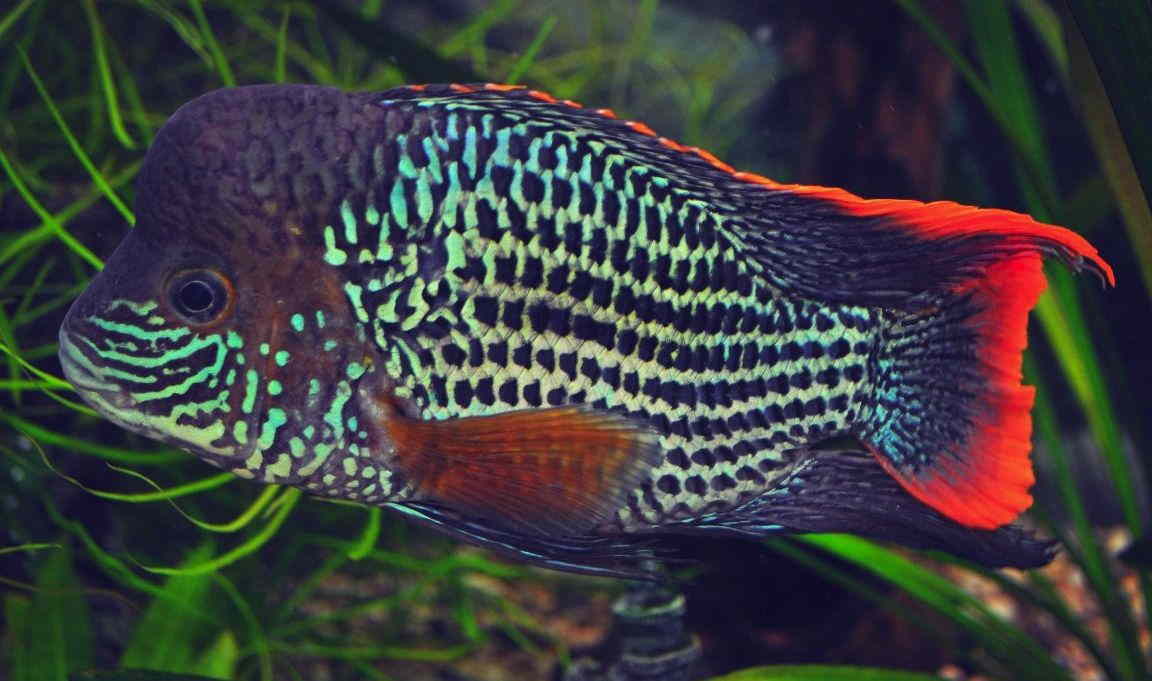
Description
Physical Characteristics
The green terror cichlid has a relatively elongated and laterally compressed body, typical of many cichlid species. As they mature, their bodies become more robust, especially in males, which are generally larger than females. Males feature elongated dorsal and pectoral fins, along with a pronounced orange stripe on the fluke edge, which can be up to 1 cm wide in some individuals. Their facial patterns consist of consistent stripes that enhance their vibrant appearance.
The primary coloration of the green terror is a striking green hue, which can vary in intensity depending on the fish’s mood, age, and environmental conditions. This green is beautifully accented with blue markings, particularly on the face, dorsal fin, and anal fin. The fish’s body often glitters with metallic blue and green shades, while the dorsal and fluke fins are outlined with an eye-catching orange line. The face displays intricate patterns of blue and green stripes and spots, making them visually captivating.
Size
In their natural habitat, green terror cichlids can grow to a maximum size of about 12 inches (30 cm). However, in aquarium settings, they typically reach around 8 inches (20 cm). In some exceptional cases, they can grow even larger, potentially exceeding 12 inches (30 cm).
Lifespan
Green terror cichlids enjoy a relatively long lifespan compared to many other aquarium fish when provided with appropriate care. On average, they can live for approximately 10 to 15 years in a well-maintained aquarium environment. With exceptional care, some individuals have been known to live even longer, occasionally reaching up to 20 years or more.
Green Terror Cichlid vs. Blue Acara
The green terror cichlid is often mistaken for the blue acara (Aequidens pulcher), and there was a time when these two species were classified as one. However, they have since been recognized as distinct species, despite their similarities.
- Size Differences: In the wild, the green terror can reach a maximum size of about 30 cm, whereas the blue acara typically maxes out at around 20 cm.
- Physical Traits: Male green terror cichlids display a noticeable rounded hump on their heads during breeding, which is less pronounced in blue acara males.
- Behavioral Traits: Green terrors tend to be more aggressive than blue acaras, making tankmate selection crucial for a harmonious aquarium environment.
| Characteristic | Description |
|---|---|
| Scientific Name | Andinoacara rivulatus |
| Common Name | Green Terror Cichlid |
| Family | Cichlidae |
| Origin | South America (Ecuador and Peru) |
| Size | Up to 12 inches (30 cm) in length |
| Lifespan | 10 to 15 years or more in well-maintained aquariums |
| Color | Green, blue, and iridescent colors |
| Temperament | Territorial and can be aggressive, especially during breeding |
| Tank Size | A 75-gallon (284 liters) tank or larger is recommended for a pair of adults |
| Water Temperature | 22°C to 28°C (72°F to 82°F) |
| pH Level | 6.5 to 8.0 |
| Hardness | Soft to moderately hard water (4-15 dGH) |
| Diet | Omnivorous, will eat both meaty and plant-based foods |
| Habitat | Slow-moving or stagnant waters, rocky bottoms, and abundant hiding spots |
| Tank Setup | Substrate of fine gravel or sand, plenty of rocks and caves, and some hardy aquatic plants |
| Breeding Behavior | Maternal mouthbrooders, females carry and protect eggs and fry in their mouths |
| Compatibility | Can be kept with larger, robust cichlids but avoid small, timid tankmates |
| Special Considerations | Maintain good water quality, provide a balanced diet, and observe interactions with tankmates |
| Conservation Status | Not evaluated (as of my knowledge cutoff in September 2021) |
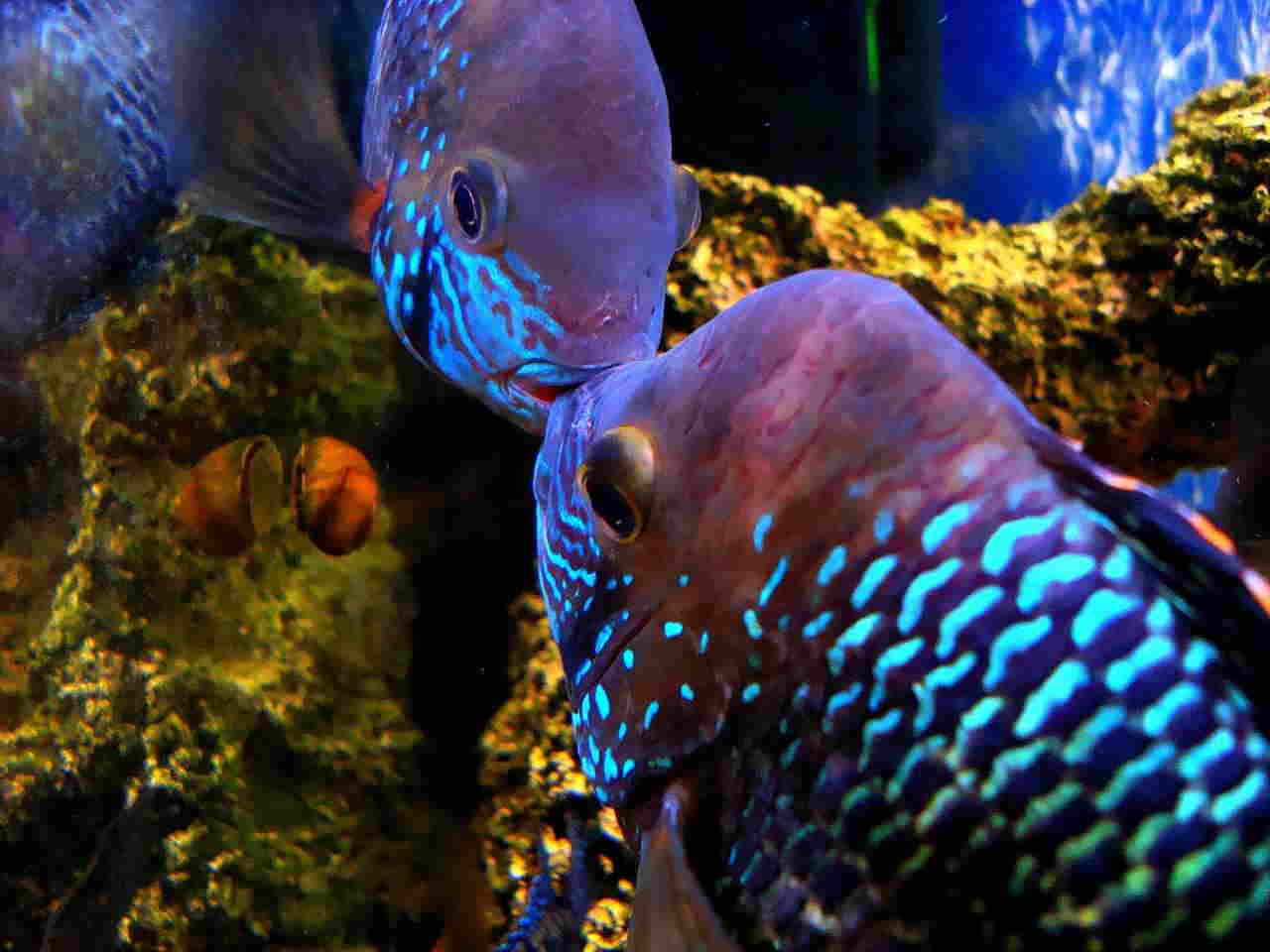
Difficulties in keeping
Although the green terror cichlid is a stunning fish that captivates many aquarists, it is not typically recommended for beginners. These fish grow large and possess aggressive tendencies, necessitating a spacious tank to accommodate their needs. A minimum tank size of 55 gallons is advisable to provide sufficient territory and reduce stress.
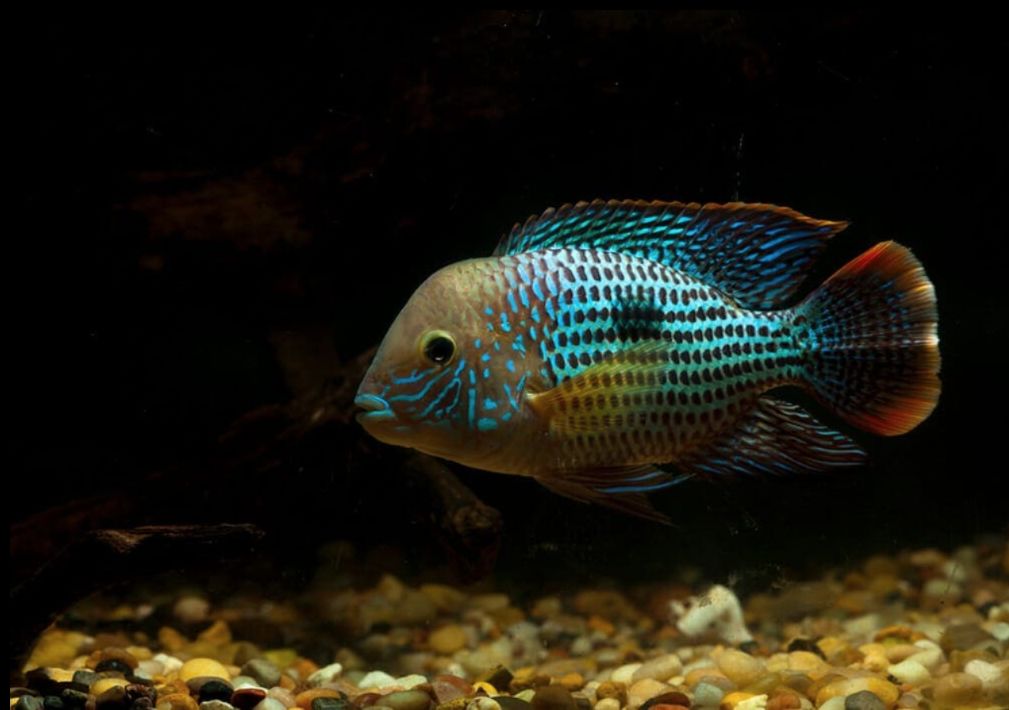
Care and keeping in a tank
Water Parameters
Maintaining stable and optimal water parameters is crucial for the health of green terror cichlids. Here are the recommended conditions:
- Temperature: 22°C to 28°C (72°F to 82°F), with an ideal range of 24°C to 26°C (75°F to 79°F). They can tolerate short-term drops to 18°C (64°F), but this should be avoided.
- pH Level: 6.5 to 8.0, ideally around 7.0 to 7.5.
- Water Hardness: Soft to moderately hard water, with a general range of 4 to 15 degrees of hardness (dGH).
- Ammonia and Nitrite: Both should be at undetectable levels to prevent toxicity.
- Nitrate: Keep nitrate levels below 20 ppm; regular water changes are essential to control buildup.
Tank Setup: Decorations and Plants
The tank should be moderately lit and designed with the typical layout for large cichlids, featuring rocks, driftwood, and a gravel bottom. Providing hiding spots, caves, and ample territories is crucial for these territorial fish. Incorporating rocks and live or artificial plants creates a more natural environment. Although green terrors do not eat plants, they may uproot them, especially during spawning. It’s advisable to choose hardy, stiff-leaved plants like Echinodorus or Anubias, securing them with flat stones or placing them in containers to minimize uprooting.
Substrate
Given their inclination to dig, the substrate should consist of small, round pebbles to prevent injuries from sharp edges. Gravel or medium-sized pebbles work well as substrates, allowing for natural digging behavior without harming the fish.
Filtration
Effective filtration is critical to maintaining water quality. Green terror cichlids are sensitive to poor conditions, so a powerful canister filter is recommended to manage waste and debris. This setup helps control nitrates and ammonia levels, promoting a healthy environment supported by beneficial nitrifying bacteria. Regular partial water changes of 20-25% of the tank volume should be performed weekly or bi-weekly. Matching the temperature and pH of the new water to that of the aquarium will help minimize stress during these changes.

Diet
In their natural habitat, green terror cichlids primarily consume a varied diet consisting of insects, their larvae, worms, and other invertebrates. This protein-rich diet is essential for their growth and health, allowing them to thrive in the wild. In aquarium settings, they are not particularly demanding and will readily accept various food types, including live, frozen, and dry options.
A well-balanced diet will include live and frozen foods like brine shrimp, bloodworms, daphnia, and mysis shrimp, which are high in protein and mimic their natural feeding behaviors. Quality dry food, such as large floating sticks or pellets designed for cichlids, is ideal for adults, as they stay on the water surface and resemble natural prey. Look for high-quality cichlid pellets formulated for South American species to provide essential nutrients.
It’s important to feed green terror cichlids multiple times a day to meet their dietary needs. This frequency helps prevent hunger-driven aggression, as hungry fish may exhibit increased prey drive and become territorial towards tank mates. As predators, they require a diet rich in protein, and the size of the food is crucial; larger adults can accommodate appropriately sized food. For juveniles, smaller flakes or pellets are recommended to ensure they receive the necessary nutrition for healthy growth. Providing a varied and high-quality diet is key to maintaining their health, color, and vitality in captivity.
Tank mates
Space is a crucial thing for all large American cichlids. Besides, it is in the spacious tank where their level of aggression decreases. Green terror is a rather battlesome fish that will provoke its tank mates itself. However, it all depends on the fish temper and tank conditions.
Some fish, when reaching their reproductive stage, become more peaceful. The same is about the green terror family – it is recommended to keep one fish couple in a tank to avoid fights. Often female is more aggressive than the male, and she is sometimes kept separate from others. During the spawning period, the fish gets completely crazy, and it’s better to keep them apart from each other.
You can’t keep green terror cichlid with small African cichlids and with angelfish since the latter will either be killed or stressed all the time. It’s better to use the following fishes as green terror cichlid tank mates: oscar, jack dempsey, arowana, convict cichlid, flowerhorn, blood parrot, jaguar cichlid, texas cichlid. You can keep it with some large catfishes, for example, sailfin pleco or suckermouth catfish.
First of all, all fishes sharing a tank with green terror cichlid should be of similar size. Any small-sized species (even average-sized ones) will be eaten sooner or later. In a perfect world, if green terrors and their tank mates live in a community tank since they are juveniles and grow together, this will ensure a decrease in their aggression.
The tank must have many various shelters for its dwellers, and its volume should be enough for large fishes to live.
During their spawning period, they become aggressive towards their tank mates. If a male or a female started to prepare a nest for laying eggs, anyone who approaches it would be immediately attacked.
Gender differences: male vs female
Green terror male and female cichlids can be challenging to distinguish, especially when they are young and not yet sexually mature. However, as they reach maturity, several observable differences emerge that can help identify their gender. These distinctions may vary among individuals, but here are some general characteristics to consider:
Males typically exhibit more intense and vibrant colors, particularly during breeding or when in prime condition, with their green and blue hues being more pronounced. Their dorsal and anal fins are often longer and pointed, with the dorsal fin sometimes featuring extended filaments. Males generally grow larger and have a more robust appearance, particularly around the head, where some may develop a noticeable nuchal hump during breeding. Behaviorally, males tend to be more territorial and aggressive, especially during the breeding season as they protect their territory and fry.
In contrast, females usually display slightly less intense colors compared to males, particularly when not in breeding condition, but they still show beautiful green and blue shades. Their dorsal and anal fins are shorter and lack the extended filaments characteristic of males. Females may be somewhat smaller and more streamlined, although this difference can be subtle. While females can also exhibit territorial behavior and protect their young, they generally display less aggression than males during breeding.
These distinctions can assist aquarists in identifying male and female green terror cichlids, contributing to better tank management and breeding practices.
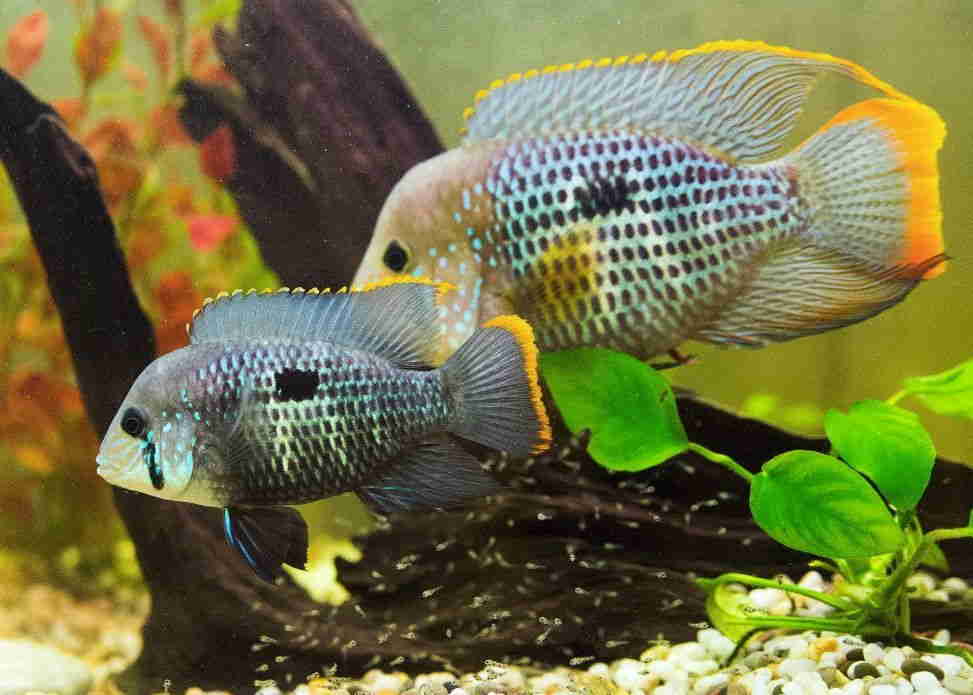
Breeding
Breeding green terror cichlids is a relatively straightforward process. Pairs form easily through random matches, so acquiring adult fish from different sources helps prevent inbreeding. If a pair doesn’t exhibit good compatibility, replacing the female can often resolve the issue. A stable pair is ideal for both breeding and general tank keeping.
Spawning can be stimulated by increasing water temperature and performing water changes; however, this isn’t strictly necessary. With optimal tank conditions, green terrors will spawn regularly. In fact, many aquarists find it more challenging to manage the frequency of spawning than to encourage it.
When it comes to choosing a breeding site, males and females will clean a suitable substrate. If they don’t find a preferred rock, they might clear sand from the tank bottom to lay their eggs directly on the glass. During this time, their coloration becomes even more vibrant, with blue markings appearing fluorescent. As part of their preparation, the fish will also dig pits in the substrate to hide their fry later.
Spawning typically occurs in the early morning or evening. The female lays her eggs while moving in a figure-eight pattern over the chosen surface, with the male closely following to fertilize them. A single clutch can contain anywhere from 200 to 300 eggs, but larger females can produce up to 1,000 eggs. Fertilized eggs are yellowish and semi-transparent. Both parents actively care for the eggs; the female fans them with her fins while the male guards the territory against potential threats, becoming quite aggressive during this period.
Sometimes, however, parents may neglect their eggs or even eat them. In such cases, the eggs should be carefully relocated to a separate incubator tank with matching water parameters. Using a gentle air stone above the eggs can help keep them aerated. Any white eggs should be removed, as they are likely unfertilized. The incubation period for the eggs is approximately 3 to 4 days, while the fry will hatch within 2 to 4 days. After hatching, the female will guide the fry to one of the previously prepared pits in the substrate.
Juvenile green terrors are relatively large and have hearty appetites. Suitable first foods include brine shrimp nauplii, microplankton or its artificial substitutes, and even crushed egg yolk. Providing a nutritious diet at this stage is crucial for their growth and development.